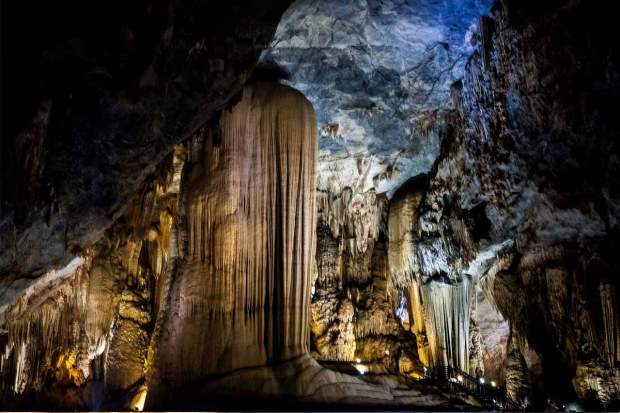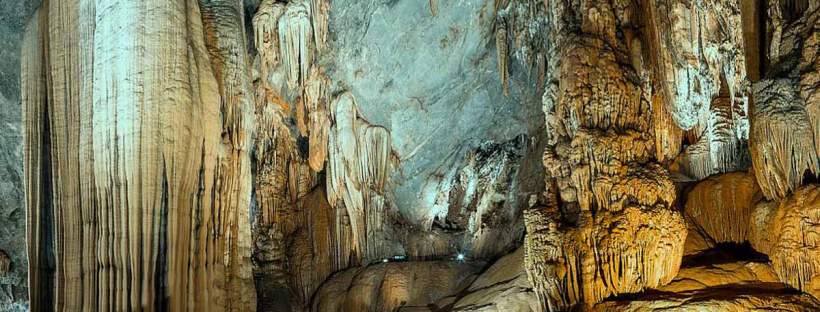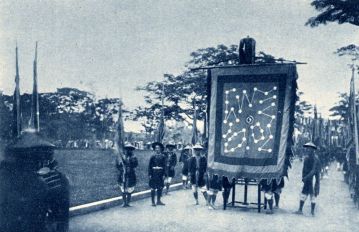Source: 1 day adventure in caving – Paradise cave – Phong Nha Ke Bang
Marble Mountain in Da Nang
Marble Mountain is one of the most attractions in Da Nang. Marble Mountain have another name is Ngu Hanh Son in Vietnamese. It’s alongside the Da Nang to Hoi An roads, just 10 km to the southeast of the central area of Da Nang.
During the American Vietnam War, they were used as a field hospital, probably within earshot of the American air field and My Khe Beach which bordered the air field on the side opposite the mountains.

They consist of 5 mountains with many mysterious caves. The outer slopes are dotted with beautiful pagodas, Buddha statues and temples and some caves even have ancient buildings inside them.
Marble Mountain have many beautiful pagodas, Buddha statues and temples and some caves
These mountains have a complicated system of caves and tunnels. Among five mountains, the highest mountain is Thuy Son – the mountain of water. Most visitors like climbing up about 150 stone steps to reach the top of Thuy Son so that they enjoy the most beautiful site: the River-view Tower or Vong Hai Tower in Vietnamese. Emperor Minh Mang built this tower in the 18th century.

Besides, you can visit carving Village located at the foot of Marble Mountains. If you come here, you can not only see the local people life as well as the culture but also buy some things like necklaces, bracelets, vases and the sculptures of Buddha made from marble stone.
In the past, to have this wonderful construction, local people extracted rocks directly from the Marble Mountains to make sculptures. However, now materials for sculpturing work are now transported from Quang Nam Province, because the government banned the direct extraction.
As there are several Buddhist sanctuaries, these mountains attract more tourists and become a famous destination. It is worth spending a little time to view.
You have just read through the above information, but feeling interesting and curious about it. Stand up and let’s go.
How to rent a motorcycle in Hue
Hue City has been known as an attractive place for both domestic and international tourists. Anyone that visits Hue is always completely attracted by palaces, temples, royal tombs which have long been attached with the imperial breath and by the presence of many ancient pagodas and traditional architecture styles. The city also has a number of places with many beautiful landscapes and other interesting destinations. Unlike Ha Noi or Ho Chi Minh City, Hue is a small and peaceful urban area. With its safe traffic, therefore, a motorbike is considered as the most convenient means when you ride a motorbike to explore this ancient capital of Vietnam. Within one or two days of riding motorbike, along with a map, tourists can visit most of the landscapes inside and outside Hue City.
Please contract us via email if you want to hire a motorbike. The motorbike will be sent to your hotel in 10 minutes. Besides, we would like to inform that rental motorbike can also be delivered to Hue Train Station, Tourism Coach Station without shipping fee. For Phu Bai International Airport, extra charge can be needed.
Beside: + You should come to our tourist office to get more information about tours, motorbikes (inside and outside the city) at 29C Chu Van An St, Hue City.
+ You can practice how to drive motorbike, scooters (Automatic, semi automatic…)
+ You will be provided free information about Hue City, outside the City and the south, the north of Vietnam.
OUR TOUR SERVICES
Come to our tourist office to get more information about:
+ City Tour by Bus – Boat, City Tour by motorbike with driver.
+ Dmz Tour by Bus, Dmz Tour by motorbike with driver.
+ Daily bus to Da nang, Hoi An, Nha Trang, Da Lat, Ho Chi Minh City, Mui Ne,…
+ Motorbike to Hoi An by yourseft, motorbike to Hoi An with Driver.
+ Pickup and transfer at the airport

1 day adventure in caving – Paradise cave – Phong Nha Ke Bang
After spending Tet in Hue, we join a tour from Hue to Phong Nha and stay at here 2 days to explore the cave in Phong Nha – Ke Bang national park. We had an overnight stay planned at Chay Lap farmstay and then onward to National Park, home of a massive cave system.
Beside the majestic Son Doong Cave, you can visit two famous cave in Phong Nha Ke Bang is Phong Nha Cave and Paradise cave.

Paradise cave is belong to Phong Nha Ke Bang national park, Son Trach, Bo Trach, Quang Binh, it’s about 60 km in the north of the Dong Hoi city. For long time ago, if you want to go this place, you must trekking 2 – 3 in the forest and climb to the hills where the entrance gate is.
And now, you can book a private car transport and they transfer you to foot of hill, from there climbing 500 steps.
Up the hill, the cave is quite small (fit one adult), therefore the temperature inside the cave always lower compared outside.
Entering the Paradise cave, you feel a cool air lanes difference with outside. You are impressed by the dome rocks, giant stalactites diversified sparkled in the lamplight.

If you don’t have more time, you just walk over 1km to discover the cave, or you can explore further 6 km further, this road will be very attractive to those who love adventure.
The inside of the caves are that cool. The walk and scenery before, during, and after being in the caves was incredible.
Paradise cave perhaps be the greatest tease of all caves known to man. Son Doong cave the largest cave in the world, is a mere 3 km. walk away, but we counldn’t go there without signing up for the tour at $3,000 a head. It’s over our budget.
Let’s plan your trip to Phong Nha and explore Paradise cave,we make sure that it’s unique experience when you travel in Vietnam
Temple Of The Jade Cup
Nine kilometers from the Hue Citadel by road toward the source of the Perfume River, Temple of the Jade Cup has long been dedicated to the Goddess Po Nagar of Champa, and later to the Goddess Thien Y A Na of Vietnam.
Date of construction of the temple was before the year 1555. The Nguyen Chronicle revealed that it was restored twice in 1832 and 1834 under Minh Mang, then enlarged and completed in 1886 under Dong Khanh, who respected the Goddess honoured in the temple. He called himself her “Younger Brother”, her his “Older Sister” and decreed two most important ritual ceremonies of the third and the seventh months of the Lunar Year to be the national festivals. Today, Dong Khanh’s portrait is still being honoured in the temple. It is him who renamed it the “Hue Nam Temple” (Temple of Grace for Southern Kingdom).
Perched on the southern side of the Jade Cup Mountain on the left bank of the Perfume River, the temple is composed of some ten constructions, all set amid verdant foliage.
Most important is the Hue Nam Temple which honours the Goddess, Emperor Dong Khanh and dozens of her leading disciples. On display inside are a great number of rare and attractive objects handed down from the past.
What could be a pleasant surprise to visitors is that if tiger is considered a beast to be exterminated at the Royal Arena, then it is sculptured and honoured on the temple grounds, just across the river.
This belief building complex is one of Hue’s beauty-spots.
Nam Giao Esplanade
Built 4km south of the Citadel in 1806, Nam Giao Esplanade, was the site where Nguyen Dynasty came to preside over sacrifice offering ceremonies to God for the country’s welfare and dynastic stability.
According to Oriental concept in monarchic times, it was on behalf of God that the Emperor, his son, ruled the country. Therefore, only he who was allowed to sacrifice to God.
Nam Giao Esplanade is an open-air monument with three terraces, one on top of another. This is the symbol of the Oriental theory of Three Agents: Heaven, Earth and Man. Topmost is a circular terrace (40m diameter) symbolizing the Heaven. Right below is a square – shape terrace (83m each side) representing the Earth. Both concepts derive from old thoughts on the Universe.
Covering an area of over 10sq. hectares, Nam Giao Esplanade comprises many constructions including minor buildings around. Shape, colour and direction of these monuments are based on the principles of Yin and Yang and Five elements (Metal, Wood, Water, Fire and Earth).
The annual Royal procession was participated by from 1,000 to 5,000 men including brilliant attendants selected from members of the Royal family, the Court and central offices. Before the ceremony started, the Emperor had to stay at the nearby Trai Cung (Fasting Residence) for some days for a vegetarian diet and rest.
Like the Temple of Literature, Nam Giao Esplanade was a support to the Vietnam’s monarchy of several dynasties deeply affected by Confucianism.
It is the only sacrifice esplanade that remain almost intact in Hue city 1 day tour today. The first ceremony took palce in 1807 in Gia Long times and the last in 1945 under Bao Dai.
Dong Khanh Tomb
 Emperor Dong Khanh was born in 1864, crowned in 1886 and breathed his last only 3 years later in 1889 at the age of 25. He was also Emperor Tu Duc’s nephew and foster-son.
Emperor Dong Khanh was born in 1864, crowned in 1886 and breathed his last only 3 years later in 1889 at the age of 25. He was also Emperor Tu Duc’s nephew and foster-son.
Since the reign of Dong Khanh, in other words, after the fall of the Capital of Hue city (5 July 1885), Vietnam completely surrendered her independence to France. In his daily life, the Emperor took to wine, perfume, using alarm – clock, etc. imported from the “mother country”.

Dong Khanh died young, having no time to start his tomb construction. Most of the monuments of the tomb were simply planned and built during the first year of Emperor Thanh Thai’s reign (1889), improved and completed in the years 1916, 1917, 1921 and 1923 under Emperor Khai Dinh (Dong Khanh’s son).
The tomb has 20 monuments, both principal and secondary. Like those proceeding Emperors (Thieu Tri, Tu Duc and Duc Duc), Dong Khanh tomb is divided into two areas, the tomb and the temple, 100m apart.
The Ngung Hy Temple, dedicated to the cult of Dong Khanh and his two Queen, is the monument of greatest value of art. Most noteworthy are the building materials and decoration. Aside from the elaborate exterior decoration, the interior is lacquered red, gilded and richly adorned.
As a whole, Dong Khanh Tomb is pretty, delicate and bears to some extent the cross – cultural stamp of European and Asian civilizations in late 19th-early 20th centuries.
Join Hue tour one day and visit Dong Khanh tomb and Hue royal tombs with us.
Gia Long Tomb
Emperor Gia Long was born in 1762 and died in 1819. His tomb was built in 6 years, from 1814 to 1820.
Being a man of strong will who had spent his life on battlefields for over a quarter of a century (1775 – 1801), he finally unified the country and came to the throne in 1802. His tomb consequently bore witness to a military commander’s unflinching character.
When his first queen died in 1814, he ordered the construction of a double-grave tomb, one for her and another for himself.
The site chosen for the purpose was an extending hilly region, some 20km by road or by water south of the Hue Citadel. Earlier, in the area, there had been tombs of his family members. When his second queen died later in 1846, her tomb was also constructed not far from his.
Amid a vast and magnificent natural environment, Gia Long Tomb has bout 20 monuments arranged in 3 groups:
– Central group: Double-grave tomb of the Emperor and Queen.
– Left group: Main monument is the Stele House sheltering the stele inscribed with the Emperor’s life story and achievements.
– Right group: Main monument is the Minh Thanh Temple dedicated to the Emperor and Queen.
Around are 42 mountains each with a name, facing the central area. Most important of these is the Great Thien Tho Mount, south of the Long Lake, which is used as a natural screen of the tomb.
A long distance from Hue city, Gia Long Tomb has been seriously damaged by war. Some basic architectural elements remain however almost intact giving us concepts of the tomb’s value.











